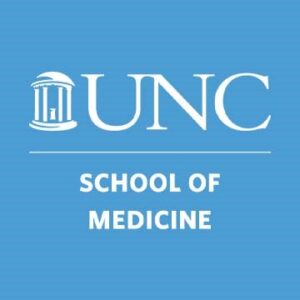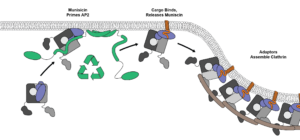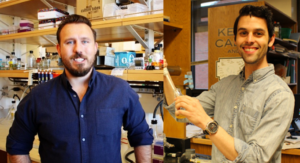
Researchers at the University of North Carolina at Chapel Hill and the UNC Lineberger Comprehensive Cancer Center have uncovered a new checkpoint that cells use to control what molecules they internalize. Understanding the determinants for entry into cells could lead to the design of better therapeutics that must enter through this gatekeeping mechanism.
Every cell in the body relies on a process called endocytosis to control what molecules are allowed inside and is often broken or misregulated in cancers and heart disease. UNC researchers now show that endocytosis has a "checkpoint" that allows for precise control of what molecules, or "cargo", are allowed inside cells.
To understand this checkpoint at the molecular scale, they teamed with a team of geneticists at the Cornell University College of Veterinary Medicine who had previously shown that a family of proteins called Muniscins are important regulators of endocytosis. Using a cutting-edge technique called cryo-electron microscopy (cryo-EM), the team showed that Muniscins alter the conformation of a key endocytic protein complex called AP2.
Their findings were published online on March 28, 2022, in Nature Structure and Molecular Biology. A free PDF version of the manuscript is available online at https://rdcu.be/cJ0ur.
"AP2 is an important protein complex and is required for controlling how many medically-relevant molecules, like viruses and cholesterol, enter cells," said UNC Lineberger's Rick Baker, PhD, assistant professor of Biochemistry and Biophysics at the UNC School of Medicine and co-lead author of this research article. "We were really surprised that Muniscins could drastically alter the shape of AP2 and that this would have profound effects on AP2 function."

Muniscins promote a specific conformation of AP2, which has not been described previously. This AP2 conformation selects for specific cargo that needs to be internalized during endocytosis.
AP2 can readily change its shape and adopt multiple conformations. The researchers found that Muniscins bind to AP2 and promote a new conformation that had not been described previously. This new Muniscin-bound conformation makes AP2 more likely to select one particular type of cargo for internalization. Once AP2 finds this cargo, the Muniscin releases the AP2-cargo complex and finds another copy of AP2 to start the process over again (Figure 1). "Muniscins seem to make AP2 fall in love with one specific type of cargo. AP2 needs to select from hundreds of possible cargo and controlling AP2 conformation seems to be one way that cells decide which cargo they want to bring inside," said Kevin Cannon, PhD, a postdoctoral researcher in the UNC Biochemistry and Biophysics department and second author of the work.

Previous research has suggested that endocytosis operates in a less controlled manner. "Researchers often like to think of endocytosis as a cellular process that runs more or less on autopilot." Rick Baker said. "Our work suggests that this process is more tightly controlled than we had previously appreciated and provides new insight into diseases like cancer where entry of one particular protein, like receptor tyrosine kinases, directly underpins the disease state."
Authors and disclosures
In addition to Rick Baker, PhD, and Kevin Cannon, PhD, the study's authors are graduate student Ed Partlow and co-lead investigator Gunther Hollopeter, both of Cornell University College of Veterinary Medicine.
This work was supported in part by grants from the National Institutes of Health, R01GM127548. The authors declare no competing interests.






